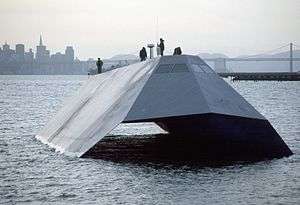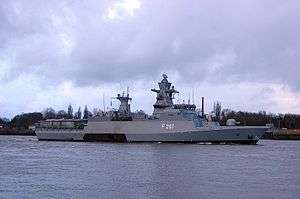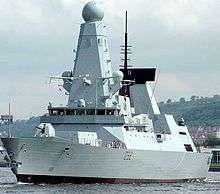Stealth ship
_at_night.jpg)

A stealth ship is a ship which employs stealth technology construction techniques in an effort to ensure that it is harder to detect by one or more of radar, visual, sonar, and infrared methods. These techniques borrow from stealth aircraft technology, although some aspects such as wake and acoustic signature reduction (Acoustic quieting) are unique to stealth ships' design. Though radar cross-section (RCS) reduction is a fairly new concept many other forms of masking a ship have existed for centuries or even millennia.
Shaping

In designing a ship with reduced radar signature, the main concerns are radar beams originating near or slightly above the horizon (as seen from the ship) coming from distant patrol aircraft, other ships or sea-skimming anti-ship missiles with active radar seekers. Therefore, the shape of the ship avoids vertical surfaces, which would perfectly reflect any such beams directly back to the emitter. Retro-reflective right angles are eliminated to avoid causing the cat's eye effect. A stealthy ship shape can be achieved by constructing the hull and superstructure with a series of slightly protruding and retruding surfaces. Furthermore, round shapes on the ship are eliminated or covered up, examples include smokestacks and gun turrets. Also cavities that present a horizontal face are to be eliminated since they act like a trap and are very visible to radar. To get around these limitations many ships use features such as panels that cover reflective surfaces or use alternate designs of hardware. Also every effort must be made to have the smallest gaps on the ship as possible. Common hull shapes include tumblehome hull designs which slope inward from the waterline, and SWATHhulls which allow for better stability when using a tumblehome hull. These RCS design principles were developed by several navies independently in the 1980s using work done on aircraft RCS reduction as the starting point.
The currently developed U.S. Zumwalt-class destroyer — or DD(X) — is the US version of a stealth ship. Despite being 40% larger than an Arleigh Burke-class destroyer the radar signature is more akin to a fishing boat, according to a spokesman for Naval Sea Systems Command;[1] sound levels are compared to the Los Angeles-class submarines. The tumblehome hull reduces radar return and the composite material deckhouse also has a low radar return. Water sleeting along the sides, along with passive cool air induction in the mack reduces infrared signature.[2] Overall, the destroyer's angular build makes it "50 times harder to spot on radar than an ordinary destroyer.[1]
Visby is designed to elude visual detection, radar detection, acoustic detection, and infrared detection. The hull material is a sandwich construction comprising a PVC core with a carbon fibre and vinyl laminate.[3] Avoidance of right angles in the design results in a smaller radar signature, reducing the ship's detection range.
Britain's Type 45 anti-air warfare destroyer has similarities to the Visby class, but is much more conventional, employing traditional steel instead of carbon fiber. Like Visby, its design reduces the use of right angles.
Sea Shadow, which utilizes both tumblehome and SWATH features, was an early U.S. exploration of stealth ship technology.
Signature reduction
Stealth technology represents more than just a low RCS; noise reduction plays a huge role in naval stealth because sound travels much better in water than air. Some of the techniques used include muffled exhaust systems, modified propeller shapes, and pump-jets. the shape of the hull can have a great effect on the reduction of the noise from a ship. Another major element is signal emission control. Modern warships emit lots of electromagnetic radiation in the form of radar, radio, and even bleed-off from the ships electrical systems. All of this can be used to track a ship and thus modern stealth ships often have a mode the switches as much of the electronic emissions off, the downside of course is that the ship then has to rely on passive sensors and cant easily send messages further than line of sight.
Also of great importance is thermal emissions. A heat signature can make a ship stand out like a candle in a dark ocean making it easier to spot and because it is possible to see infra-red emissions through features that would normally hide a ship such as fog, or a smoke screen, many detection platforms like patrol aircraft, UAV's, and satellites often have the ability to see multiple bands in the infrared spectrum including heat. This necessitates the control of these emissions. The most common way is to mix any hot gasses emitted by the main source of heat which is the engines exhaust with cold air to dilute the signature and make it harder to pick out the ship from the background warmth. Another method vents the exhaust into the water though this increases the ships acoustic signature. For the hull water can be actively distributed across the hull of the ship cooling the ship. Another less crucial but still relevant part of a stealth ship is visual camouflage. This area is probably the oldest form of stealth, with records going back almost as far as writing of ancient mariners using visual tricks to make their ships harder to spot. Though still relevant this areas has taken on lesser importance with the advent of long range radar.
Materials
Just like choices in shaping, the choice of materials effects the RCS of a ship. Composites such as fiberglass and carbon fiber are great blockers of radar and give smaller vessels an advantage in further RCS reductions. However composites are fragile and often unsuited to larger ships or ships that expect to take fire, though new laminates can partially negate some of the weaknesses. This restricts larger ships to metals such as steel and aluminum alloys. To compensate a ship may include a coating of a radar absorbing material though this can be quite expensive and may not stand up to the corrosive effects of salt water.
Examples
Fully stealth ships
- Type 45 destroyer
- Formidable-class frigate
- Hamina-class missile boat
- Visakhapatnam-class destroyer
- La Fayette-class frigate
- Independence-class littoral combat ship
- Sea Shadow (IX-529)
- Skjold-class corvette
- Visby-class corvette
- Zumwalt-class destroyer
- Kolkata-class destroyer
- Houbei-class missile boat
- Shivalik-class frigate
- Ada-class corvette
- Horizon-class frigate
- Klewang
Ships with moderate radar cross-section reduction
- Legend-class security cutter
- De Zeven Provinciën-class frigate
- Holland-class offshore patrol vessel
- F125-class frigate
- Freedom-class littoral combat ship
- Sachsen-class frigate
- Talwar-class frigate
- Type 052C destroyer
- Type 052D destroyer
- Type 054A frigate
- Tatarstan/Gepard-class frigate
- Kamorta-class corvette
- Buyan-class corvette
- Steregushchiy-class corvette
- FREMM multipurpose frigate
- Ambassador MK III missile boat
Reduced radar cross-section ships
- Braunschweig-class corvette
- Gerald R. Ford-class aircraft carrier
- Arleigh Burke-class destroyer
- San Antonio-class amphibious transport dock
- Atago-class destroyer
- Sejong the Great-class destroyer (KDX-III)
- Chungmugong Yi Sun-sin-class destroyer (KDX-II)
- Gumdoksuri-class patrol vessel
- Neustrashimyy-class frigate
- Rotterdam-class amphibious transport dock
- Kedah-class offshore patrol vessel
- Álvaro de Bazán-class frigate
- Sigma-class corvette
- Nongo class
- Admiral Grigorovich-class frigate
- PZM patrol vessel
Planned ships
Gallery
-

HMS Helsingborg, one of the Swedish Navy's Visby-class corvettes
-

French frigate Surcouf of the La Fayette class
-

Dutch frigate Evertsen of the Zeven Provinciën class
-

Indian stealth frigate INS Shivalik, lead ship of her class
-

German Braunschweig-class corvette
-

Type 45 Royal Navy destroyer
-

Horizon-class frigate of the French Navy and Italian Navy
See also
References
- 1 2 Patterson, Thom; Lendon, Brad (14 June 2014). "Navy's stealth destroyer designed for the video gamer generation". CNN. Retrieved 29 October 2014.
- ↑ "DDG-1000 Zumwalt / DD(X) Multi-Mission Surface Combatant". GlobalSecurity.org. 1 September 2008.
- ↑ "Visby Class, Sweden". www.naval-technology.com. Retrieved 2015-07-31.
- "Stealth on the Water" "Mechanical Engineering"
External links
- DDG 1000 information; formerly DD(X)
- Shivalik class frigate
- Stealth ships steam ahead article by Chris Summers on BBC news, 10 June 2004